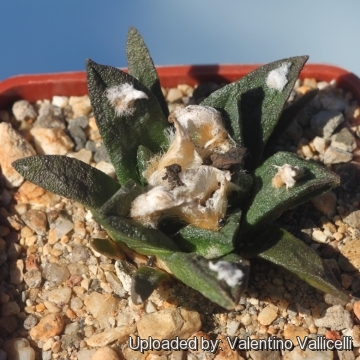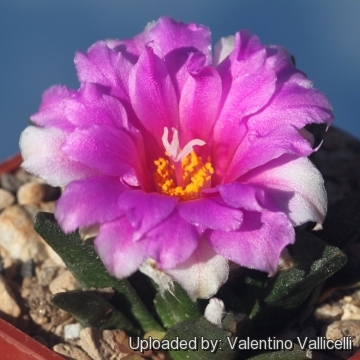
Ariocarpus hybrid fissuratus x agavoides Photo by: Valentino Vallicelli
Origin and Habitat: Garden origin (Nursery produced hybrid)
Synonyms:
Description: It is a small slow growing solitary cactus obtained by crossing ♀ Ariocarpus fissuratusSN|2073]]SN|2114]] x ♂ Ariocarpus agavoidesSN|2114]]SN|847]]. The superb features of this rare plant are due to the intersection between the traits of the ancestors. It has inherited by Ariocarpus agavoidesSN|2114]]SN|847]] the long dark tubercles and by Ariocarpus fissuratusSN|847]]SN|2114]] the papillose and fissured surface. The flower are also very beautiful and reminds those of the Ariocarpus fissuratusSN|847]]SN|2114]]. It is however quite variable due to its hybrid origin and, at first glance, looks like a larger sized Ariocarpus bravoanusSN|2114]]SN|2073]].
Habit: It is a geophyte plant that produces a small star-shaped rosette of fleshy tubercles.
Stem: Subglobose, flattened on top, 3-6 cm high, rising barely above ground level, that grows extremely slowly, to7-10 (or more) cm in diameter. The stem is usually solitary, rarely giving rise to side shoots from old areoles.
Tubercles: Dark olive-green, adpressed in young individuals, ascending or divergent, triangular to lance shaped in outline, acute at the apexes, deltate in cross section, not incurved, flattened adaxially, but becoming conspicuously concave at maturity, irregularly papillose at apex, sometimes with the papillae forming one or two lateral furrows, usually 2-3 times as long as wide. (to 3-7cm long and 2 cm wide basally), and with the edges sharply acute.
Areoles: Confined to middle of adaxial tubercle faces instead of extending to tips, rounded to more or less elliptic, 2-5mm diam, woolly.
Spines: It have no spines.
Roots: Each plant has a large turnip-like taproot, which lies below the soil surface and serves for water storage.
Flowers: These plants have a woolly crown, from which emerge bright pink-violet flowers up to 5 cm in diameter, 2 times wider than long when fully expanded. Flowers last for 3 to 4 days.
Blooming season: October, November.
Fruits: Not seen.
Subspecies, varieties, forms and cultivars of plants belonging to the Ariocarpus hybrid group
 Ariocarpus hybrid fissuratus x agavoides Photo by: Valentino Vallicelli
Ariocarpus hybrid fissuratus x agavoides Photo by: Valentino Vallicelli Ariocarpus hybrid fissuratus x agavoides Photo by: Valentino Vallicelli
Ariocarpus hybrid fissuratus x agavoides Photo by: Valentino VallicelliCultivation and Propagation: It’s a relatively easy species to cultivate, but very slow growing. Needs a very well drained soil. Requires strong sun to part sun to develop good spinal growth and waterings should be rather infrequent, to keep the plant compact and not become excessively elongated and unnatural in appearance. Keep dry in winter, or when night temperatures remain below 10° C (but some people give this plant a light monthly watering to prevent the drying and shedding of the lower tubercles.) it is hardy to -4°C for a short period. Assure a good ventilation.
Propagation: It can be reproduced by seeds. Young seedlings are tiny and they need several years to reach adult size, and require very careful watering. Many growers graft tiny 2-3 month seedlings and they grow on very successfully that way.












